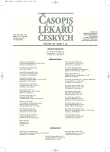Peripheral Arterial Occlusive Disease versus Depression Symptoms and Quality of Life
Authors:
L. Slováček 1,2; MUDr. Birgita Slováčková, Ph.D. 3; V. Chovanec 4
Authors‘ workplace:
Katedra válečného vnitřního lékařství, Fakulta vojenského zdravotnictví Univerzity obrany, Hradec Králové
1; Oddělení klinické hematologie, II. interní klinika LF UK a FN, Hradec Králové
2; Psychiatrická klinika LF UK a FN, Hradec Králové
3; Radiodiagnostická klinika LF UK a FN, Hradec Králové
4
Published in:
Čas. Lék. čes. 2006; 145: 788-791
Category:
Original Article
Overview
Background.
The study has three main aims:
1. it evaluates occurrence of depression symptoms in patients with peripheral arterial occlusive disease (PAOD), 2. it evaluates global quality of life (QoL) in patients with PAOD and 3. it evaluates effect of age and stage of PAD on seriousness of depression symptoms and on the QoL in patients with PAOD. Patients and Method: the study is local, prospective and cross-sectional. It was carried out at the 2nd Internal Clinic of University Hospital in Hradec Králové. Data were obtained during the year 2006.
Methods and Results.
The total number of respondents with PAOD was 42 (28 male, 14 female). The average age of all respondents with PAOD was 65.4 years and age range was 45-79 years. The evaluation of occurrence of depression symptoms in patients with PAOD was performed by means of self-assessment Zung-SDS and evaluation of QoL in patients with PAOD was performed by means of Czech version of international generic European Quality of Life Questionnaire – EQ-5D Version. Statistical significance was determined by means of analysis of variance. Main The mean SDS index certifies the presence of signs of minimum or light depression in patients with PAOD. The QoL in patients with PAOD is on the low level. The above-mentioned aspects proved statistically significant dependence of QoL in patients with PAOD on depression (p<0.001), on age (p<0.01) and on stage of PAOD (p<0,01). We proved statistically significant dependence of depression in patients with PAOD on age (p<0.01) and on stage of PAOD (p<0.01).
Conclusions.
The results show the existence of the association between PAOD and depression symptoms with its negative effect on QoL in patients.
Key words:
peripheral arterial occlusive disease, depression symptoms, quality of life.
Labels
Addictology Allergology and clinical immunology Angiology Audiology Clinical biochemistry Dermatology & STDs Paediatric gastroenterology Paediatric surgery Paediatric cardiology Paediatric neurology Paediatric ENT Paediatric psychiatry Paediatric rheumatology Diabetology Pharmacy Vascular surgery Pain management Dental HygienistArticle was published in
Journal of Czech Physicians

Most read in this issue
- Photodynamic Therapy with Visudyne in Treatment of Wet Form of Age-Related Macular Degeneration – Two Years Results
- Peripheral Arterial Occlusive Disease versus Depression Symptoms and Quality of Life
- Role of Percutaneous Vertebroplasty and Kyphoplasty in the Treatment of Oncology Disorders of the Spine
- Cardiac Myxoma in the Left Atrium Resulting in Syncopes
